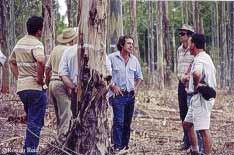|
|
|
|
|
Diagnosis

A farm forestry diagnosis is a review of
aspirations, opportunities and constraints of the farmer, the
role that trees and forests might play in meeting these, the
possible market opportunities available and the associated product
or service specifications. This is a starting point for the
design of appropriate farm forestry options.
Because every farm is different, no single farm forestry design
will be appropriate for all farmers. There are physical, environmental,
social and economic factors that vary significantly from farm
to farm and between regions. Physical factors that will affect
farm forestry design include soil types, climate and the farm’s
aspect. Social and economic variables that vary from farm to
farm include:
the age and number of farm family members and their interests
• farm size
• the availability of off-farm income
• tax liabilities
• available skills and equipment
• farming systems
For complex, multipurpose long-term ventures like farm forestry,
it is essential for the design to match the interests, aspirations,
resources and constraints of those whom it is meant to serve.
Market analysis aims to identify the product prices and specifications
that might be gained from potential purchasers of farm forestry
products and services. These depend on the products and services
the farmers might be able to provide and include:
• log processors
• seed merchants
• catchment management groups
• water authorities
• school groups
• tourists.
Every farmer thinking about establishing a farm forest must
first identify:
• what the market is looking for
• what price the market will pay
• delivery and sale mechanisms for the products.
Farmers’ design
criteria
Market specifications
Back to top
|
|
|
